Francis Kéré, first African Pritzker Price winner
Born in Burkina Faso, he is the first African architect to win the most prestigious architecture award.
From Burkina Faso to Berlin: an artistic revelation
Diébédo Francis Kéré is the protagonist of a successful life against all odds. Born in 1961, Francis Kéré grew up in absolute poverty, in a small African village, a land without clean water, electricity, infrastructure… or architecture.
His village called Gando, located in Burkina Faso (West Africa), made up of a small group of grass-roofed huts, had not even the slightest amenities. There wasn’t even a school.
His father was the local chief and had the vision of sending the boy to study in the neighbour village and later in the country’s capital, Ouagadougou. His goal was that the kid could read for him the official documents he received as tribal chief.
All the inhabitants contributed to pay for his studies. This is how the youngster became the first in his village who knew how to read and write. Without forgetting his humble origins, Francis Kéré seized the opportunity and went much further than being a simple reader.
At a very early age, his marked taste for architecture developed in response to the lack of comfort in his life, both at home and at school. The lack of ventilation and light in the cement classroom where he spent hours with a hundred children, made him feel the need to change. He then made a firm resolution to build a better school… one day.
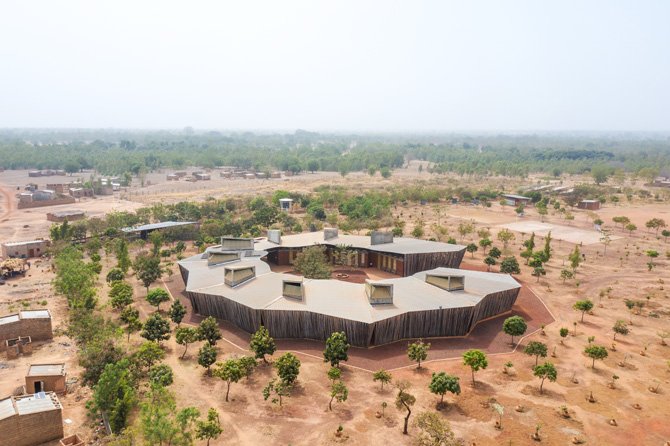
From his early childhood, he dreamed of enlarging the walls and letting the spaces breathe. He did not imagine then that his first important work would be precisely a school for his small village.
With only twenty years old, he got a vocational training scholarship that took him to study carpentry in Berlin. He learned German and after ten years of very hard economic and personal efforts, going through all kinds of jobs, he obtained a second scholarship with which he achieved his dream and his passion: to study architecture.
He gained admission to the Technische Universität in Berlin (Technical University), where he finally obtained his architecture degree shortly before his 40th birthday (2004).
But Francis Kéré always thought of his community of origin and with great effort and determination, he managed to obtain altruistic financing in Germany. His goal: to build a school in his village so that other children could have access to education without leaving the village and walking for hours.
In 1998 he created a foundation with his name to raise funds and claim the right of children to study in a proper classroom. His first work, in collaboration with his native countrymen, many volunteers, was the Gando Elementary School (1999-2001). With this work he won the prestigious Aga Khan Award in 2004. This award is given to architectural works within the Muslim world, especially projects that demonstrate an early sensitivity to sustainable architecture. That same year, 2004, Francis Kéré opened his own studio in Berlin.
The Gando School, was started in 1999. Just that year, the Pritzker Prize was won by Sir Norman Foster, author of HSBC, the Hong Kong Bank. The great paradox is that this was the most expensive building in history when it was completed in 1986. Those were times of splendour for show architecture and “star architects”.
Meanwhile, Francis Kéré, built a modest school in his hometown. It was made with earth and handmade bricks, under a separate structure with a roof that serves as an umbrella, without mechanical systems of any kind and raised by hand by the neighbours, many of them volunteers.
In that period, other “mega stars” won the Pritzker Prize, such as Rem Koolhaas (2000) and Herzog & de Meuron (2001). In the following years Zaha Hadid (2004), Thom Mayne (2005), Richard Rogers (2007) and Jean Nouvel (2008) would receive it, coinciding with the global financial crisis of 2008, caused specifically by the real estate fall.
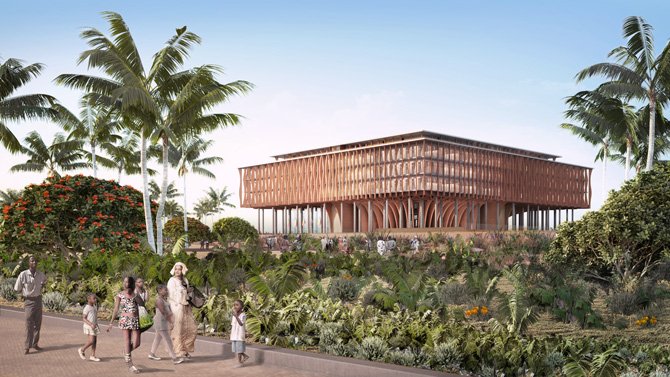
During the decade of the 20’s Francis Kéré created other buildings and establishments in Burkina Faso, Kenya, Mozambique and Uganda as part of a vast project. His goal was to improve the well-being of the native communities.
The Burkinabé architect has always been committed to social justice and the right of all to better living conditions. In his own words, Francis Kéré told the newspaper “Le Monde”:
I had this idea, that even the most poor and destitute have a right to live in comfort and beauty.
Sophistication at the service of well-being
“He knows, from his deep inside, that architecture is not about the object but the objective. It is not about the product, but the process” underlines the jury in a press release.
This is how his work on local materials is of major importance in his creation. The African architect explores hybrid forms that create a dialogue between the traditional and the contemporary, using local materials that bring a breath of modernity and creativity.
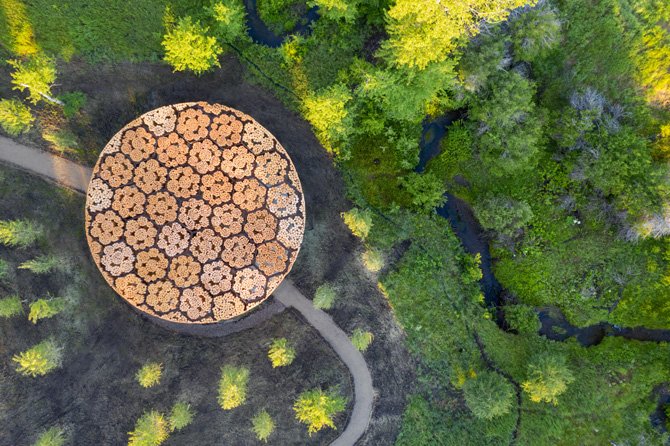
Francis Kéré contributes to the debate by integrating the local, national, regional and global dimensions in a very personal balance between field experience, academic quality, low tech, high-tech. It’s truly a combination of sophisticated multiculturalism.
The sensitivity and humanity of this architect can be seen in his projects, designed for and with local communities, while the use of natural materials (wood, granite, clay, etc…) and the promotion of reuse and recycling testify to his ecological concerns.
The recognition of his work was not granted exclusively to the merit of the company achieved, but also to the quality of his architectural concepts, to the sophisticated intelligence that connected the necessary with the beautiful and the useful. Also with what was possible, since it incorporated construction techniques and accessible materials, which the users and builders themselves were capable of handling.
This continued with other projects in his native village: teachers’ housing in 2004, the expansion of the school in 2008 and the library in 2010. The Secondary School and the Women’s Center came later.
Francis Kéré’s work seemed to respond to a program of human development, carried out from the studio of an architect capable of giving each work a deep and necessary meaning, changing the destiny of his community.
Between utopia and pragmatism
Unstoppably, Burkina Faso and other African territories felt that they had found in this young man, an apostle capable of leading their projection into the future. He received other commissions in his home land, in Dano and in Laongo, and later in Mali he created the Center for Earthen Architecture in Mopti (2010) and the installations for the National Park of Mali in Bamako (2010).
Most of the works came from poor countries around him, which recognised his talent and effort: Mali, Mozambique, Kenya, Togo and Sudan.
The pride and confidence that he has been able to transmit to his compatriots materialised with the commissioning of the project for the new Parliament of Burkina Faso. He resolved it with a symbolic pyramid of habitable surface, covered with gardens, orchards and stands. It is pending construction.
The National Assembly of Benin, in Porto Novo, is currently under construction, demonstrating that Kéré has managed to become a symbol of the African renaissance and an icon of the hope with which he looks to the future of the entire continent.
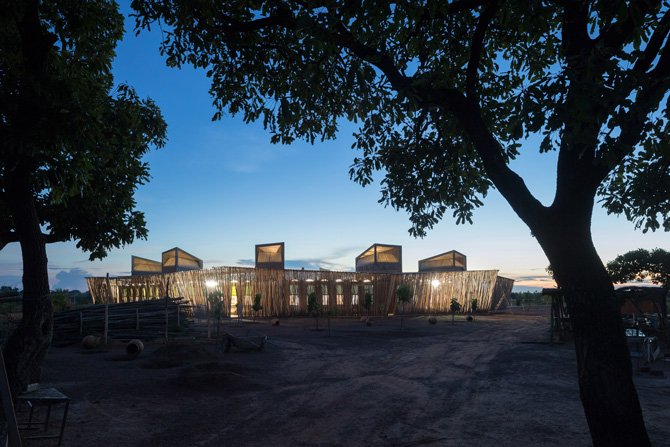
In 2017 he published his book “Radically Simple” where he tells the value of collaborating with native residents. Francis Kéré places social and historical needs at the heart of his creative thinking. His main commitment is with his own native community.
Technical skill and tight budgets have not been able to contain his remarkable creative capacity, which is present in utilitarian works such as the Liceo Schorge High School in Koudougou (2016), and in numerous pavilions with artistic purposes designed for Germany, Denmark, Italy, United States, United Kingdom and Switzerland.
In the United States he has built Xylem (2019), an open-air pavilion for the Tippet Rise Art Center in Montana. It evokes the living structure of a tree, a beautiful place to gather or meditate.
His best-known work is the brilliant pavilion made in 2017 for the Serpentine Gallery in London. There he plays with two autonomous elements, a roof and a curved wall, to create a spatial game that alludes to the large solitary tree under which the community in his village held their meetings.
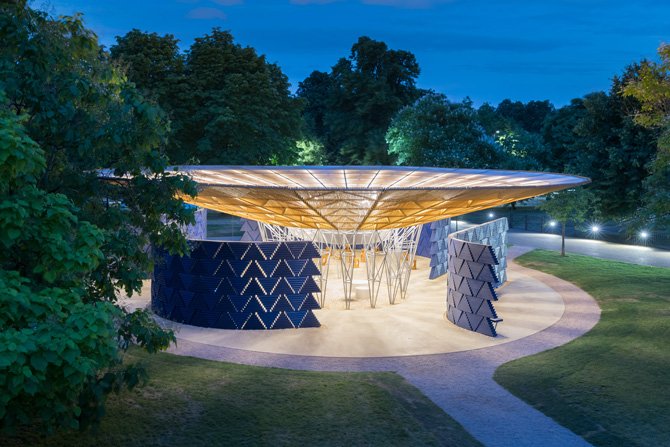
He also transferred the idea from London to the installation of his exhibition at the ICO Museum in Madrid in 2018. Made by himself, it is his only work in Spain… till this date. The exhibition was a sample of the type of materials and forms that he normally uses: mud walls, textile curtains, masses with wooden trunks, light metallic elements. They are collected by the curator, Luis Fernández-Galiano, in a splendid catalogue.
I was lucky enough to be able to visit this exhibition and I remember it as an explosion of colour covering curved and counter-curved walls. It was an immersion in interesting enveloping environments of sinuous forms that worked beyond pure construction. They seemed to embrace the visitor with the warmth of their colourful African paintings.
Global change of perspective
Never like today have we been so aware of the times change. The global pandemic and the war in Ukraine are just the last drops in the ocean of global transformation.
Since the world crisis of 2008, the spectacular architectural waste has lost its reputation. It is true that they remain in places linked to the business of fossil energy sources, but the implicit reproach of this type of project has meant that the cultural environment of architecture has changed its paradigm.
The new heroes work with earth and sticks, in places of extreme poverty. They carry out works with microscopic budgets but maintain bridges with Europe and North America. They give visibility to a rigorous and demanding work, often flying between the First World in which they have their studios, and the Third World where they carry out their works. They leave the least harmful carbon footprints, establishing connecting vessels between the most distant places on the planet with the lowest income per capita and those with the highest quality of life.
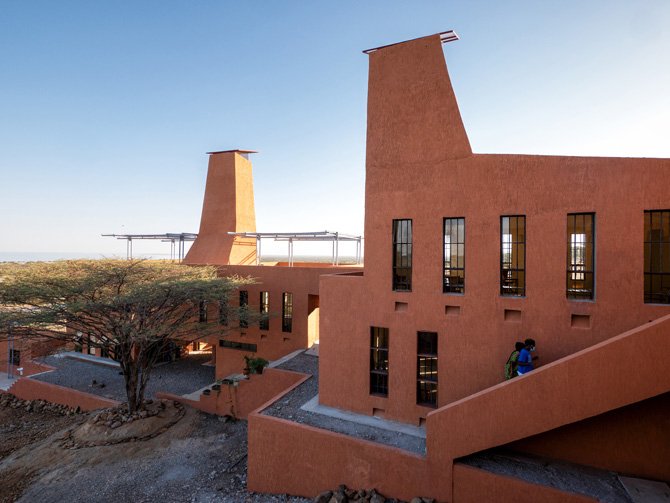
Nourished by roots on two continents, the sap of Kéré’s architectural tree drinks from the best of both worlds, achieving a personal and universal synthesis at the same time, which gives his works a classic, archetypal and timeless character.
He is about a formidable, sensitive, committed, intelligent, astute and visionary architect, who discovered the way to make a revolution a reality with palpable examples.
What he imagined, that rural school for his village in Burkina Faso, became a reality. He found a way to finance and carry it out. Furthermore, the initial model was used for new buildings around it and later, for other places that saw that this type of action was possible. A single man changed the future of his entire town.
The architect often says, in relation to the youngest Africans, that they must be warned that they will not find their future in Europe. He tips that they must be kept in their countries by financing projects like his, to keep them rooted in their native countries. His words and works reflect his personality, empathy for his fellow men, a simple joy that comes from the usefulness of his job, from his ability to contribute to harmony and happiness.
He has the firm will to serve as an example to the most young. He shows a sincere lack of prominence that has not been able to hide his enormous value, both professional and human.
Francis Kéré’s work reminds us of the struggle needed to change unsustainable patterns of production and consumption, as we strive to provide adequate buildings and infrastructure for billions of people in need.
This does not even imply that the inequality gap has narrowed, nor that the practice of architecture distances itself from the interests of the real estate market, but it marks a path that must be traveled so that architecture reaches the most needy and that the construction practices are compatible with the future of the planet.
Unlike almost any other architect, Francis Kéré stands for the association of constructive, social, and cultural aspects of building. He made a name for himself not only with his designs for Christoph Schlingensief’s Opera Village Africa.
He has received numerous international awards, primarily for his building projects in his native country of Burkina Faso. His structures join his formal training in Berlin Technische Universität with the traditional building methods of his native origins. In doing so, he places local social and historical needs at the center of his design concepts.
The innovative thing about this work is that he relies on the inhabitants. They are trained to become professionals and thus the constructors of their own future. His book “Radically Simple” is the first monograph on his extensive oeuvre and provides unique insight into the creative work of this outstanding architect. He renders visible the fact that architecture not only revolves around buildings, but always around people as well.
Pritzker Prize, “the Nobel of Architecture”
The Pritzker was created by businessman Jay Pritzker in 1979. It is considered the “Nobel for Architects”, rewarding those who have made a significant contribution. Awarded by an independent jury, it brings visibility and recognition to the winner, with $100,000 financed by Hyatt, the international hotel chain.
This 2022 award represents a continuation in the change of perspective on the architectural panorama that the Pritzker jury has maintained in recent years. They have awarded sustainable and supportive attitudes in the works of Shigeru Ban (2014), Alejandro Aravena (2016), the Indian Balkrishna Doshi (2018) and the Anne Lacaton and Jean- Philippe Vassal team last year.
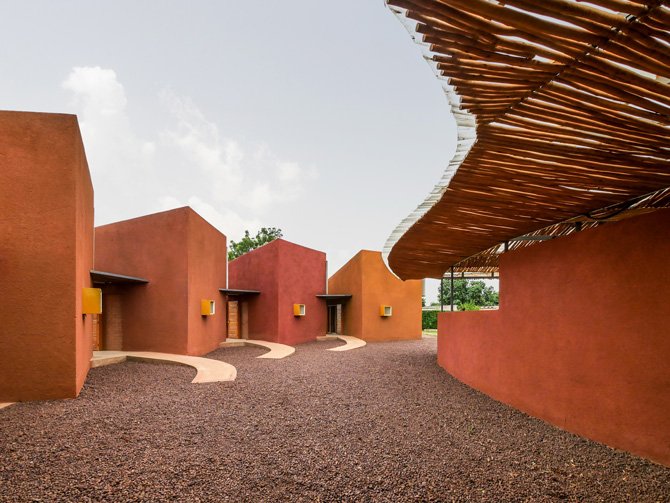
For this 2022 edition, the Pritzker is a fair award since Francis Kéré is particularly known for his commitment to greater social justice. It also involves the participation of local communities in his projects and the use of natural materials. He has just became the first African to receive the supreme distinction in the world of architecture. Francis Kéré is a freelance creator, whose prestige has grown in the opposite direction to the architecture that the jury of these awards chose when he started working.
I hope I have been able to demonstrate the power that a community has and how architecture can be something that inspires every community to shape its future.
Kéré’s commitment and sense of responsibility with his own people is the value that the jury has highlighted to make him the winner this year. Francis Kéré’s work does not speak about himself.
He speaks about the need of those who receive it and about the respect with which they should be treated, even if they are the poorest clients in the world. Also because his passion and work is aimed at the wellbeing of his compatriots in a country like Burkina Faso, one of the countries with the lowest income per capita even within Africa.
In the world of successful architects, Francis Kéré represents authentic values and his work is full of truth and love for his fellow men.

